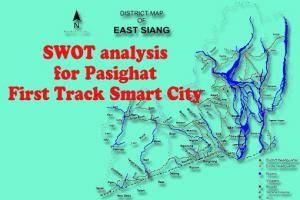We bring to you this wonderful news that our city-Pasighat has been selected under 23 fast track cities by Govt. of India and we need to submit the revised plan by 15th April 2016. As we know that we worked very hard in our previous attempt however unfortunately we missed coming in the first 20 list of cities and finished at 39th rank - missing by just 3 points. Let us take this as a positive feedback that we were very close to winning it and were far ahead of many other big cities.
Looking ahead, we need to work on the gaps identified by Govt. of India to revamp the proposal. One of the key weaknesses identified is SWOT (Strength, Weakness, Opportunities and Threat) analysis. Here, specifically, Weakness and Threat needs to be more elaborate. We have uploaded a discussion page on mygov portal about this aspect of proposal and need support of people of Pasighat to come up in big numbers and contribute towards this discussion. Let’s brace up for this challenge and work with renewed and reinvigorated spirit in the direction of making Pasighat a smart city.
Click here to view the Smart City Proposal
Click here to view the gaps identified by Ministry of Urban Development, Govt of India
The last date to submit your suggestions / comments is 30th March, 2016.



I dream of a smart pasighat which will be well equipped with proper water management, urban mobility, E- Governance and proper citizen services, proper energy management, other basis facilities like tele medicine, tele education and skill development centre.
Our pasighat has huge sustainable resources but because of improper utilization of it is the economic draw able here. which can be improved through up gradation and proper utilization these resources.I being one of the smart citizen of pasighat to be the smart city would contribute in building of through propagations and awareness campaigns in our country
Traditional mode of governance is robust in the area and in sync with mainstream governance. This will certainly contribute to smooth transition from a normal city to smart city in future.
Lack of community/ public toilets have been stated in the SWOT as a weakness. However it must be mentioned that pasighat is free from open defecation. And the city is limited in size as well as population. Need for those facilities may only come up at the altar stages when greater development takes place and people converge for economic activities from different places.
Natural scenic spots can be beautiful and made accessible to tourist as well as locals keeping into consideration hygiene and aesthetics of the area. Participation of locals have to be encouraged to make it more unique in terms of both location as well as people.
applicants, and citizens regarding land and building development. Development applications involve City staff as well as Community Association Land Use Development Services provides policy, regulation, and plan guidance to City Council, development Committees and Council and Council's standing and advisory committees.
Educational system today is the result of remarkable progress made as a result of using information and communication technologies. Educational system aims to become intelligence through intelligent systems, modern information and communication technologies. If the students will be educate, they will know to work for a sustainable city and they will have in view the limits of natural resources.
In the smart city proper drainage system should be implementing. Availability of water is necessary in a city. Our pasighat should have all this facilities. Rivers should be cleaned. Every school must have natural resource can be use for the production of electricity. Cleaned. City is require.
The population of the city should be counted and recorded. The smart city mission requires people who activity participate in governance and reforms, these people involves themselves in the definition of smart city since smart city is taking compact area approach it is necessary that all the city residents feel there is something in it for them also.
Quality of life and the attractiveness of a city are profoundly influenced by the core systems of a city: transport, government services and education, public safety and health.